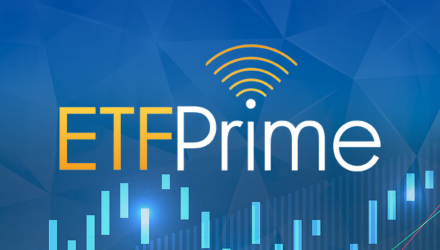On this week’s ETF Prime, host Nate Geraci sat down with VettaFi’s Tom Lydon to cover several topics including ETF flows, ARK Invest, and Schwab’s new crypto ETF. Geraci also spoke to DoubleLine’s Jeff Sherman regarding the firm’s recent ETF entrance and the current fixed income market, and to Dimensional’s Anthony Caruso to go over the remarkable growth of the company’s ETF business.
Tom Lydon on the Market
Since July 1, the S&P 500 has been up 8%. The Nasdaq-100 is up 13%. Even broad bonds, which had their worst start to a year ever, are currently positive.
“Cathie Wood’s lineup is up almost 35% off those lows. We’ve seen some nice stability in the S&P. And what’s surprising, Nate, is small-caps,” Lydon said, noting that small-cap stocks have outperformed expectations. ETFs like the iShares Russell 2000 ETF (IWN) have benefited from the strong U.S. dollar and rising interest rates. “A lot of advisors are diversifying into small-caps for the first time in years.”
Looking at valuations, Lydon sees them as being in a Goldilocks position where they aren’t too expensive or too cheap. He also sees signs of optimism in the market. “We’ve got clarity from the Fed on what they are trying to do to fight inflation, so there’s less concern about rising interest rates, there’s more clarity in the bond market, and there’s some sense of optimism that inflation will get under control, which bodes well for the stock market and the bond market.”
According to VettaFi’s polling on their feelings about the market, 6% of advisors were “very optimistic,” 50% had “reserved optimism,” 39% had “mild pessimism,” and 5% were “very pessimistic.” Almost two-thirds of advisors think the market will be higher in 12 months. Geraci noted that this is an incredibly bullish sentiment given where the market has been.
Looking at flows, Lydon sees money coming back to bonds, consistency in equity, and an uptick into currency. The Invesco Long Dollar ETF (UUP) is benefiting from that uptick. “There’s a lot of feelings that we’re going to continue to see a strong dollar during times of uncertainty,” said Lydon. A lot of investors feel that it might be too late to ride the commodities boom, but Lydon underscored that many smart people think that the train still has plenty of track ahead of it. He pointed to flows into gold ETFs, noting that gold is typically a “second-half” player in recessions.
Though ARK’s flagship fund, the ARK Innovation ETF (ARKK), is still down on the year, it continues to see flows. “Yes, they’ve had devastating performance since February of last year, but flows continue to come in,” Lydon said. He thinks that investors have their eyes on long-term growth and are taking advantage of valuations.
The Schwab Crypto Thematic ETF (STCE) recently launched, taking Geraci by surprise given how conservative Schwab usually tilts. Not only is STCE a thematic ETF, but it’s also playing in the deep end by providing exposure to the crypto space, which is currently reeling. The fund doesn’t invest in cryptocurrencies or crypto futures, but it has exposure to companies like MicroStrategy (MSTR) that are all in on crypto. STCE has access to miners, chip makers like Nvidia, and even exchanges such as Coinbase. “It is a great way to get into that ecosystem, and boy, for picking the right time — crypto is not going away, and it has been crushed lately, so the probabilities they will be able to put big numbers up in the next five years are really good,” Lydon said. Geraci sees a crowded space, but does concede that the 30 bps price gives it an advantage. Bitcoin is up 20% since July 1.
DoubleLine Is Feeling Double Fine With Its 2 ETFs
After a wide-ranging discussion with Lydon, Geraci was joined by DoubleLine’s Jeff Sherman to discuss the company’s new ETFs, the DoubleLine Opportunistic Bond ETF (DBND) and the DoubleLine Shiller CAPE U.S. Equities ETF (CAPE). Together, these ETFs have $120 million in AUM despite launching as recently as April.
DoubleLine is, of course, a big name in asset management, but these products are its first foray into the ETF space outside of sub-advising three SPDR ETFs, including the SPDR DoubleLine Total Return Tactical ETF (TOTL).
Sherman sees DBND as a “core plus” ETF that seeks out golden opportunities in the fixed income marketplace. It can buy a variety of fixed income products that could help propel it past the Barclay’s Aggregate Bond Index. “We think this is the perfect substitute for those who don’t want to just be at the mercy of the issuance of the government and the investment-grade cooperate bond market,” Sherman said.
CAPE is a large-cap U.S. equity strategy that focuses on sector rotation using Professor Shiller’s cape ratio to find the cheapest sectors for finding valuation. Though it leans on Shiller’s methodology, it’s an actively managed product in a semi-transparent wrapper.
Dimensional’s 2-Year Run
In less than two years, Dimensional has gone from no ETF assets to over $60 billion. Geraci spoke to Anthony Caruso to discuss Dimensional’s rapid ascent to being one the biggest ETF issuers in the space. Though many of the assets come from mutual fund conversions, Dimensional has seen almost $20 billion in inflows. That alone would make it a top-20 issuer.
Its wide range of ETFs, which feature 19 equity products, four fixed income products, and a newly launched real estate fund, have an asset-weighted average cost of 23.5 bps. Last week’s guest, Elizabeth Kashner, specifically called out the low fees that Dimensional provides, noting how they have helped the company garner inflows in a bear market. Caruso noted that its fees are closer to passive funds than active ones and said, “we bring the benefits of passive and marry that with active.”
Listen to the Entire Episode of ETF Prime With Tom Lydon:
For more ETF Prime podcast episodes, visit our ETF Prime channel.

